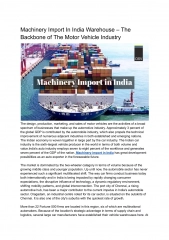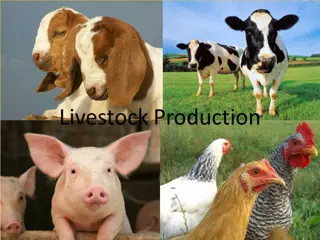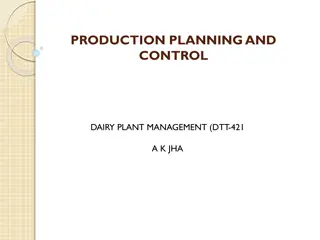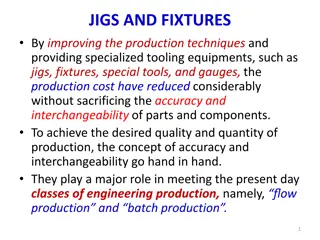Global Industry-Level Production
Significance of industry-level production accounts in analyzing economic growth, global linkages, competitiveness, and productivity comparisons. Learn about KLEMS and Global Value Chain (GVC) accounting for a comprehensive understanding of global production structures and value attribution.
Download Presentation

Please find below an Image/Link to download the presentation.
The content on the website is provided AS IS for your information and personal use only. It may not be sold, licensed, or shared on other websites without obtaining consent from the author.If you encounter any issues during the download, it is possible that the publisher has removed the file from their server.
You are allowed to download the files provided on this website for personal or commercial use, subject to the condition that they are used lawfully. All files are the property of their respective owners.
The content on the website is provided AS IS for your information and personal use only. It may not be sold, licensed, or shared on other websites without obtaining consent from the author.
E N D
Presentation Transcript
A Global Integrated Industry-Level Production Account Jon D. Samuels and Erich H. Strassner Fifth World KLEMS Conference June 4-5, 2018 Cambridge, MA
Motivation Industry-level production account for the world economy Economic questions: Contributions of individual countries, industries, and factors of production, to world economic growth Capture global linkages in production Competitiveness and productivity level comparisons Approach: Extend country-level production account to reflect international trade and price level differences This presentation: KLEMS and Global Value Chain (GVC) Accounting Background on country-level production accounts BEA experience on constructing an integrated aggregate-industry account Components of a world production account 2
KLEMS and GVC Accounting GVCs: origins of economic value Production is fragmented across countries, but economic accounting statistics are compiled nationally United Nations Handbook on Accounting for Global Value Chains Conceptual framework for compiling GVC statistics Ground-up approach, using firm-level data on specific industries and final products of an MNE: Extended Supply- Use Tables (SUTs) or GVC-specific satellite accounts AND Extended global SUTs, OECD-WTO TIVA accounts, or the World Input-Output Tables 3
KLEMS and GVC Accounting Inherently linked by overlapping conceptual issues and data requirements Measuring global production, attributing sources of value, underlying SUTs/IOTs And, are used to analyze complementary questions Analytical purposes of GVC: origins of economic value Integrated KLEMS is used to analyze growth and competition: Country-industry level contributions to world economic growth Analyze international competition: industry price level indexes Industry-country multifactor productivity level comparisons Essential for economic policy and analysis of globalization 4
Industry-level Production Account Permits a bottom-up analysis of the sources of economic growth within a country, including the contributions of capital (K), labor (L), and intermediates (EMS) Output side of the account includes nominal and real industry output and value added Aggregating over industry value added produces real GDP growth from the industry side The input side of the account includes nominal and real estimates of intermediate and capital and labor inputs used by industry MFP is the ratio of the quantity of output to the quantity of input SNA (2008) discusses deflators for capital and labor services are covered in chapters 19 and 20. Thus, all of the pieces to construct a country-level production account are included in the SNA 2008 5
Growth Accounting Requires an industry-level production account Industry-level outputs and inputs in current and constant prices Symmetric treatment of outputs, intermediate inputs, and primary inputs ??? = ??? ?? ??? ?? ??? ?? ??? ?? ??? ?? ??? Consistent with aggregate GDP constructed within SUT Framework: In United States, BEA-BLS collaboration Gross output, intermediate input, value added: BEA Capital input: BLS, based on BEA Fixed Assets Labor input: Hours from BLS, Composition from BEA 6
Sources of U.S. Economic Growth, 1987-2016 Average Annual Percentage Point Contribution 4.0 3.0 2.0 1.0 0.0 Integrated MFP -1.0 Labor Input -2.0 Capital Input -3.0 1987-2016 1987-2007 2007-2009 2009-2016 7 Source: BEA-BLS Integrated Industry-level production account
Industry Capital Contributions to Economic Growth 2009-2016 less 1987-2007 Computer and electronic products Computer and electronic products Construction Construction IT Equip. & Software Insurance carriers and related activities Insurance carriers and related activities Other Miscellaneous professional, scientific, and technical services and technical services Miscellaneous professional, scientific, Wholesale trade Wholesale trade Broadcasting and telecommunications Broadcasting and telecommunications Rental and leasing services and lessors of Rental and leasing services and lessors of intangible assets intangible assets Retail trade Retail trade Federal Reserve banks, credit intermediation, and related activities intermediation, and related activities Federal Reserve banks, credit Real estate Real estate -0.25 -0.2 Average annual percentage point -0.15 -0.1 -0.05 0 8
A Global Integrated Industry-Level Production Account The World and EU KLEMS initiatives provide proof of concept for implementing country-level accounts Consortium of researchers and economic statisticians Data for about 40 countries Common classification system for industries, outputs, and inputs Based on official data Next steps: Integrating the country-level data to account for world trade 9
World Production Account Input-output table From Nomura and Miyagawa, 2015 Based on Japan-US Input- output Table produced by METI 10
Price Competitiveness Industry Contributions to Japan-U.S. Price Gap, 2005 Wholesale and Retail Real Estate Electricity and Gas Agriculture, Forestry, Fishing Medical Care Motor Vehicles -6.0 -4.0 -2.0 0.0 2.0 4.0 6.0 8.0 Average Annual Percentage Point Contribution 11 Source: Jorgenson, Nomura, Samuels (2016)
World Production Account MFP Level Comparisons Requires outputs and inputs in common units PPPs at the industry and commodity level For outputs and intermediate inputs, this involves comparing prices for homogeneous goods For primary inputs, PPPs defined analogously For labor: unit price is comp/hour for workers cross classified by industry, sex, age, education For capital: rental price by industry and asset Putting this all together yields MFP level comparisons by industry 12
MFP Level Comparisons Industry Contributions to Japan-U.S. TFP, 2005 Source: Jorgenson, Nomura, Samuels (2016) Note, this is a bilateral comparison only 13
Way Forward KLEMS and GVC analysis are inherently linked by overlapping conceptual issues and data requirements And, are used to analyze complementary questions. Analytical purposes of GVCs: origins of economic value Integrated KLEMS is used to analyze growth and competition Essential for economic policy and analysis of globalization Prototype exists from (Jorgenson, Nomura, Samuels 2016) Both are integral components of a global accounting system UN Handbook on GVC Accounting will make this case Next steps 14























